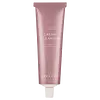What's inside
What's inside
 Key Ingredients
Key Ingredients

 Benefits
Benefits

 Concerns
Concerns

 Ingredients Side-by-side
Ingredients Side-by-side

Water
Skin ConditioningGlycerin
HumectantSesamum Indicum Seed Oil
EmollientRubia Cordifolia Root Powder
Skin ConditioningCetearyl Alcohol
EmollientCetearyl Glucoside
EmulsifyingGlyceryl Stearate
EmollientCetearyl Olivate
Sorbitan Olivate
EmulsifyingDehydroacetic Acid
PreservativeBenzyl Alcohol
PerfumingAcacia Senegal Gum
MaskingXanthan Gum
EmulsifyingTocopherol
AntioxidantPelargonium Graveolens Oil
MaskingSodium Benzoate
MaskingWater
Skin ConditioningCetyl Ethylhexanoate
EmollientGlycerin
HumectantCyclomethicone
EmollientTitanium Dioxide
Cosmetic ColorantBetaine
HumectantCetyl PEG/PPG-10/1 Dimethicone
EmulsifyingHydrogenated Polydecene
EmollientNiacinamide
SmoothingDimethicone
Emollient1,2-Hexanediol
Skin ConditioningBeeswax
Emulsion StabilisingSodium Hyaluronate
HumectantSodium Chloride
MaskingQuaternium-18 Bentonite
Sorbitan Sesquioleate
EmulsifyingBambusa Vulgaris Leaf Extract
Skin ConditioningRose Extract
Skin ConditioningWine Extract
AntioxidantSucrose
HumectantMineral Salts
Skin ConditioningButylene Glycol
HumectantGluconolactone
Skin ConditioningSodium Benzoate
MaskingGlycyrrhiza Glabra Root Extract
BleachingDiospyros Kaki Leaf Extract
Skin ProtectingMorus Alba Bark Extract
Skin ConditioningOpuntia Coccinellifera Fruit Extract
Skin ConditioningCI 77492
Cosmetic ColorantCI 77491
Cosmetic ColorantCI 77499
Cosmetic ColorantIsopropyl Myristate
EmollientTriethyl Citrate
MaskingAcrylates/Ammonium Methacrylate Copolymer
Triethoxycaprylylsilane
Allantoin
Skin ConditioningTocopheryl Acetate
AntioxidantAdenosine
Skin ConditioningParfum
MaskingDisodium EDTA
Water, Cetyl Ethylhexanoate, Glycerin, Cyclomethicone, Titanium Dioxide, Betaine, Cetyl PEG/PPG-10/1 Dimethicone, Hydrogenated Polydecene, Niacinamide, Dimethicone, 1,2-Hexanediol, Beeswax, Sodium Hyaluronate, Sodium Chloride, Quaternium-18 Bentonite, Sorbitan Sesquioleate, Bambusa Vulgaris Leaf Extract, Rose Extract, Wine Extract, Sucrose, Mineral Salts, Butylene Glycol, Gluconolactone, Sodium Benzoate, Glycyrrhiza Glabra Root Extract, Diospyros Kaki Leaf Extract, Morus Alba Bark Extract, Opuntia Coccinellifera Fruit Extract, CI 77492, CI 77491, CI 77499, Isopropyl Myristate, Triethyl Citrate, Acrylates/Ammonium Methacrylate Copolymer, Triethoxycaprylylsilane, Allantoin, Tocopheryl Acetate, Adenosine, Parfum, Disodium EDTA
Ingredients Explained
These ingredients are found in both products.
Ingredients higher up in an ingredient list are typically present in a larger amount.
Glycerin is already naturally found in your skin. It helps moisturize and protect your skin.
A study from 2016 found glycerin to be more effective as a humectant than AHAs and hyaluronic acid.
As a humectant, it helps the skin stay hydrated by pulling moisture to your skin. The low molecular weight of glycerin allows it to pull moisture into the deeper layers of your skin.
Hydrated skin improves your skin barrier; Your skin barrier helps protect against irritants and bacteria.
Glycerin has also been found to have antimicrobial and antiviral properties. Due to these properties, glycerin is often used in wound and burn treatments.
In cosmetics, glycerin is usually derived from plants such as soybean or palm. However, it can also be sourced from animals, such as tallow or animal fat.
This ingredient is organic, colorless, odorless, and non-toxic.
Glycerin is the name for this ingredient in American English. British English uses Glycerol/Glycerine.
Learn more about GlycerinSodium Benzoate is a preservative. It's used in both cosmetic and food products to inhibit the growth of mold and bacteria. It is typically produced synthetically.
Both the US FDA and EU Health Committee have approved the use of sodium benzoate. In the US, levels of 0.1% (of the total product) are allowed.
Sodium benzoate works as a preservative by inhibiting the growth of bacteria inside of cells. It prevents the cell from fermenting a type of sugar using an enzyme called phosphofructokinase.
It is the salt of benzoic acid. Foods containing sodium benzoate include soda, salad dressings, condiments, fruit juices, wines, and snack foods.
Studies for using ascorbic acid and sodium benzoate in cosmetics are lacking, especially in skincare routines with multiple steps.
We always recommend speaking with a professional, such as a dermatologist, if you have any concerns.
Learn more about Sodium BenzoateWater. It's the most common cosmetic ingredient of all. You'll usually see it at the top of ingredient lists, meaning that it makes up the largest part of the product.
So why is it so popular? Water most often acts as a solvent - this means that it helps dissolve other ingredients into the formulation.
You'll also recognize water as that liquid we all need to stay alive. If you see this, drink a glass of water. Stay hydrated!
Learn more about Water